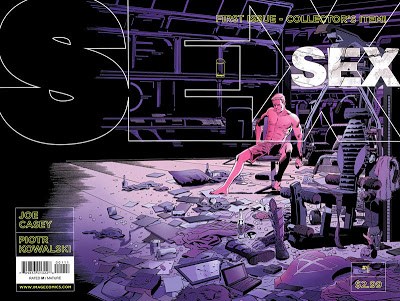Oh, my. It’s been a while since I posted on this blog, but I didn’t think it was THAT long.
Why so long away? Simply put, I’ve been busy with other things — work things that pay money, such as editing special advertising supplements for the local major newspaper. And some of this coincides with a dearth of comics material I was excited about enough to write about.
Anyway, I’m back and plan to do as much with this blog as I can in the near future. Don’t expect daily updates, but I’ve been plowing through some of the massive stacks of graphic novels and comics that have accumulated around me and want to talk about them and some of the overall trends of interest I’m seeing in the medium.
I’m also thinking about some regular features that I’d like to do, including an issue-by-issue re-read of the Stan Lee and Jack Kirby run on Fantastic Four and some critical looks at individual comic-book movies that I’m thinking of calling “The Essential Comic Book Movies.” But, we’ll see …
To start off, let’s look at some of the latest books, both old and new, that I’ve cleared off my reading pile the past couple of week. I’ve got a few of these written up and will spread out the posting dates over the next little while to give everyone a reason to come back.
By far the most impressive comic I’ve read in ages is Epic’s 1980s reprint of Blueberry 2: Ballad for a Coffin (Epic, $14.95, 1989), by Jean-Michel Charlier and Jean “Moebius” Giraud. It’s a crime against art that these stories are not in print constantly for readers to take up. I’m not an expert on Westerns in comics (though Kirby and Simon’s Boys’ Ranch is on my list of to-acquire books), but this is an astonishingly excellent series. Paced somewhat like a classic comic strip, though without the constant need to recap the story, these two volumes see the anti-hero Mike Blueberry assigned a secret mission to recover a half-million dollars in Confederate gold thought hidden over the Arizona border.
The story is detailed in the way a good novel is, standing in stark contrast to the slack movie-style plotting of most modern American comic books. Each page of these books, printed in the old Marvel graphic novel style, could be split in half much like the old Carl Barks duck stories were. And something actually happens in each half page — there’s plenty of script and story crammed into each segment, and it’s all well researched and full of believable character-defining script and art.
It’s Giraud, so I should not have to tell anyone that the art is fucking gorgeous. Having lived and worked in southern Arizona, I can tell you the scenery is dead-on accurate. The art also is lush, full, fluid and full of the best kind of old-school draftsmanship, detail and composition. Everything is pleasing to the eye — no matter how closely you look — while still telling the story and just plain looking RIGHT. And still, it’s nothing like Giraud’s science-fiction work as Moebius (more on that soon). The only element that is occasionally a problem for me is the coloring — by Giraud himself — which is at times garish and overpowers the detail in the art. But that may be a technological problem related to the times they were done in, versus the capabilities of the late 1980s and what could be done with this material now — were it actually in print.
I’m glad I’ve got a couple more volumes of this in hand to read and fall in love with.
You wouldn’t know it from a cursory look, but the same hand draws the amazing mess that is Moebius 3: The Airtight Garage (Epic, $12.95, 1987). This is one of the grand comics masters’ best-known efforts, though it’s certainly a harder row to hoe. It helps that Moebius explains in the introduction how this was written — each two- or three-page segment was done in an almost random way, with only the final segment making any kind of effort to wrap up and bring cohesion to the story. So it is that he sets up the reader for the idea that the ideas and imagery are the most important elements of this tale. And in those respects, The Airtight Garage lives up to its reputation.
There’s a lot of just plain cool stuff going on here, and it all kind of works as long as you don’t expect much of a story. From what I read online afterward, it seems like this story is most notable as the jumping off point for other Moebius stories that take place in this universe. Such stories hold a lot of promise, even as this version of The Airtight Garage, for all its visual virtues, falls short as a story in its own right.
Like this:
Like Loading...





